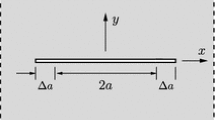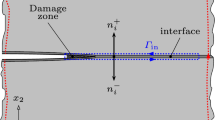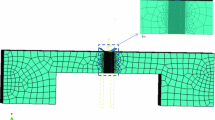Abstract
Non-conventional fracture test geometries such as single cantilever bending, clamped beam bending and clamped wire bending have been developed over the years to suit the needs of micro- and nano-scale testing. The same geometries can also be used at the macro-scale if testing standards are well established. Development of length scale compatible geometries helps the materials engineer to seamlessly extract material properties across multiple length scales. This article proposes the crack driving force (or energy release rate G) criteria for the above three geometries. These geometries have found widespread use at the micro-scale and can be adapted to the macro-scale. Use of a global energy-based criterion instead of the local stress-based criteria (stress intensity factor K) has its own advantages, especially in multi-phase materials and interface-dominated structures which display an R-curve. Aspects of crack stability even under load control arising because of the geometric factors, especially the beam or wire aspect ratio, are discussed in this context. Validation of the compliance approach is carried out by comparing it to the J-integral extracted directly for a linear elastic material using extended finite element modeling and also using the analytical formulation for a double-cantilever beam specimen. Experimental evidence of the validity of the solutions in determining the fracture energy of a linear elastic brittle material, PMMA, as a homogeneous model system is shown.






Similar content being viewed by others
References
A.A. Griffith, Philos. Trans. 221, 163. (1920).
G.R. Irwin, Fracturing of Metals (American Society for Metals, Cleveland, 1948), p 147.
L.B. Freund and S. Suresh, Thin Film Materials: Stress, Defect Formation and Surface Evolution (Cambridge University Press, Cambridge, 2003).
T.H. Courtney, Mechanical Behaviour of Materials (Waveland Press, Long Grove, 2005).
D.P. Clausing, Int. J. Fract. Mech. 5, 211. (1969).
F.I. Baratta, Int. J. Fract. 62, 29. (1993).
J.I. Bluhm, Analysis and Mechanics (Pergamon Press, New York, 1978), p 409.
T.L. Anderson, Fracture Mechanics: Fundamentals and Applications (CRC Press, Boca Raton, 2005).
F.I. Baratta and W.A. Dunlay, Mech. Mater. 10, 149. (1990).
G. Dehm, B.N. Jaya, R. Raghavan, and C. Kirchlechner, Acta Mater. 142, 248. (2018).
B.N. Jaya, S. Bhowmick, S.A.S. Asif, and V. Jayaram, J. Mater. Res. 30, 3343. (2015).
K. Matoy, H. Schönherr, T. Detzel, T. Schöberl, R. Pippan, C. Motz, and G. Dehm, Thin Solid Films 518, 247. (2009).
B.N. Jaya, S. Bhowmick, S.A.S. Asif, and O.L. Warren, Philos. Mag. 6435, 1945. (2015).
M.A. Monn, K. Vijaykumar, S. Kochiyama, and H. Kesari, Nat. Commun. 11, 1. (2020).
G. Sernicola, T. Giovannini, P. Patel, J.R. Kermode, D.S. Balint, T. Ben Britton, and F. Giuliani, Nat. Commun. 8, 9. (2017).
B.N. Jaya and V. Jayaram, Int. J. Fract. 188, 213. (2014).
A.K. Mishra, A. Lambai, V. Jayaram, and B.N. Jaya, Theor. Appl. Fract. Mech. 105, 102409. (2020).
J. Ast, M. Ghidelli, K. Durst, M. Göken, M. Sebastiani, and A.M. Korsunsky, Mater. Des. 173, 107762. (2019).
Y.W. Mai and A.G. Atkins, J. Strain Anal. Eng. Des. 15, 63. (1980).
J.H. Underwood, F.I. Baratta, and J.J. Zalinka, Exp. Mech. 31, 353. (1991).
B.N. Jaya and V. Jayaram, JOM 68, 94. (2016).
K. Venkatraman and V. Jayaram, Philos. Mag. 99, 2016. (2019).
M.R.M. Aliha and M.R. Ayatollahi, Mater. Sci. Eng. A 527, 526. (2010).
M.G. Mueller, V. Pejchal, G. Žagar, A. Singh, M. Cantoni, and A. Mortensen, Acta Mater. 86, 385. (2015).
S. Brinckmann, C. Kirchlechner, and G. Dehm, Scr. Mater. 127, 76. (2017).
E. Breitbarth, T. Strohmann, M. Besel, and S. Reh, Frattura Ed Integrita Strutturale 13, 12. (2019).
Acknowledgements
The authors would like to acknowledge the TATA Center for Technology and Design, IIT-Bombay, for providing laser machining facilities for PMMA specimen, the FIST Laboratory at the Department of MEMS, IIT-Bombay, for providing the mechanical testing facility for the PMMA experiments and the Max Planck Partner Group Project and the IITB Seed Grant for financial support.
Author information
Authors and Affiliations
Corresponding author
Ethics declarations
Conflict of Interest
On behalf of all authors, the corresponding author states that there is no conflict of interest.
Additional information
Publisher's Note
Springer Nature remains neutral with regard to jurisdictional claims in published maps and institutional affiliations.
Supplementary Information
Below is the link to the electronic supplementary material.
Rights and permissions
About this article
Cite this article
Chaudhari, T.S., Mathews, N.G., Mishra, A.K. et al. Energy Release Rate Formulations for Non-conventional Fracture Test Geometries. JOM 73, 1597–1606 (2021). https://doi.org/10.1007/s11837-021-04637-7
Received:
Accepted:
Published:
Issue Date:
DOI: https://doi.org/10.1007/s11837-021-04637-7




